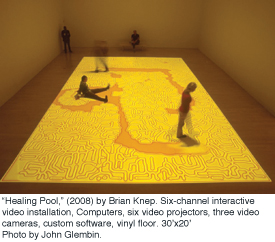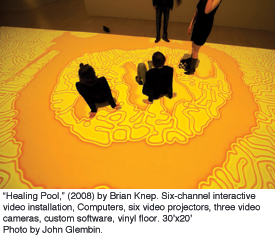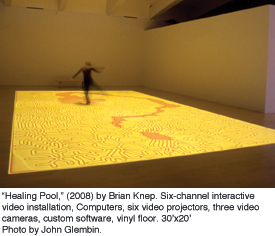Kimura Gallery: 'Healing 1' by Brian Knep - March 27-April 18, 2013
by Michelle Saport |
 On display: "Healing 1" (2013) by Brian Knep. A single-channel interactive video installation
using a computer, video projector, video camera, custom software and vinyl floor.
Dimensions variable.
Location: Kimura Gallery (Fine Arts Building, Second Floor)
Show Dates: Wednesday, March 27-Thursday, April 18
Opening: Wednesday, March 27, 5:30-7:30 p.m. (There is free parking in the Fine Arts Building
parking lot after 5:30 p.m.)
On display: "Healing 1" (2013) by Brian Knep. A single-channel interactive video installation
using a computer, video projector, video camera, custom software and vinyl floor.
Dimensions variable.
Location: Kimura Gallery (Fine Arts Building, Second Floor)
Show Dates: Wednesday, March 27-Thursday, April 18
Opening: Wednesday, March 27, 5:30-7:30 p.m. (There is free parking in the Fine Arts Building
parking lot after 5:30 p.m.)
This exhibition is sponsored by the University of Alaska Anchorage's Complex Systems Group and Department of Art.
"Healing 1" uses custom algorithms to create a glowing pool of organic patterns on the floor. Left alone, the patterns slowly pulsate and shift over the course of each day. When a person walks across the piece the patterns tear apart and rebuild themselves, but never exactly as before. The change is similar to a scar left behind when a wound heals. Thus the pool holds a history, or memory, of all the interactions that have occurred since the piece was first turned on.
This project serves as a type of memorial, a constantly evolving record of change that honors the minuscule ways in which the slightest interactions--no matter how small or unintentional--have some impact. It is also an examination of how each person is, like the pool, a manifestation of everything that came before.
 Knep on the Healing series:
"The pieces in the Healing series explore interaction and integration: the changes,
both destructive and regenerative, that happen when things interface with each other.
They are interactive floor projections with patterns that change in response to visitors.
When visitors walk across, the patterns pull away, creating wounds. When left alone,
the patterns grow to cover these wounds. In each of the pieces, however, the patterns
grow back in different ways.
Knep on the Healing series:
"The pieces in the Healing series explore interaction and integration: the changes,
both destructive and regenerative, that happen when things interface with each other.
They are interactive floor projections with patterns that change in response to visitors.
When visitors walk across, the patterns pull away, creating wounds. When left alone,
the patterns grow to cover these wounds. In each of the pieces, however, the patterns
grow back in different ways.
This work is related to the research being done on artificial intelligence and artificial life, but the path and goal are different. Most explorations in these fields attempt to create human-like intelligence and behavior, and in so doing they use more and more complex algorithms and techniques. In contrast, with these pieces I am focusing on the complexity possible with very simple rules. The patterns and their growth are completely emergent phenomena; they arise from the mathematical equations that the software simulates. The basis for these equations comes from biological and chemical models of molecular interactions, interactions that are at the core of all living things. By amplifying them and making them visible and accessible, they become metaphors for human behavior and interaction.
These pieces are not life-forms, but they exhibit life-like behaviors, behaviors that are simple in their goals (to grow) but complex and subtle in their realization (how the piece actually grows and reacts to visitors). Visitors quickly understand how the pieces react to them, but the subtlety creates many possible, often surprising, interactions. Visitors enjoy playing with the pieces and exploring new ways of interacting with them. They experiment and watch and learn from each other. The pieces encourage them to interact not only with the vinyl floor, but also with each other."
 About the artist:
Brian Knep is a media artist working with cutting-edge science and technology. As
the artist-in-residence at Harvard Medical School, he works side-by-side with scientists,
co-opting their tools and techniques to explore alternative meanings and ways of connecting
to the world. Knep's works range from microscopic sculptures for nematodes to large-scale
interactive installations. His work has been shown at the RISD Museum, Milwaukee Art
Museum, New Britain Museum of Art, McColl Center for Visual Art, Hudson Valley Center
for Contemporary Art and others. Knep's "Deep Wounds," commissioned by Harvard University,
has won awards from Ars Electronica, the International Association of Art Critics
and Americans for the Arts, who selected it as one of the best public-art projects
of 2007. He also has grants and awards from Creative Capital, Massachusetts Cultural
Council and the LEF Foundation among others.
About the artist:
Brian Knep is a media artist working with cutting-edge science and technology. As
the artist-in-residence at Harvard Medical School, he works side-by-side with scientists,
co-opting their tools and techniques to explore alternative meanings and ways of connecting
to the world. Knep's works range from microscopic sculptures for nematodes to large-scale
interactive installations. His work has been shown at the RISD Museum, Milwaukee Art
Museum, New Britain Museum of Art, McColl Center for Visual Art, Hudson Valley Center
for Contemporary Art and others. Knep's "Deep Wounds," commissioned by Harvard University,
has won awards from Ars Electronica, the International Association of Art Critics
and Americans for the Arts, who selected it as one of the best public-art projects
of 2007. He also has grants and awards from Creative Capital, Massachusetts Cultural
Council and the LEF Foundation among others.
Knep holds a bachelor's degree in mathematics and computer science and a master's degree in computer science, both from Brown University. He also studied ceramics at the Radcliffe Ceramics Studio and glass blowing at Avon and Diablo Glass. Early in his career he worked as a senior software engineer at Industrial Light & Magic, working on films such as "Jurassic Park," "Mission Impossible" and "Star Trek: Generations." While there, he developed tools including two for which he and three others were awarded technical Academy Awards. Knep also helped found Nearlife, a high-end design and technology company, creating interactive experiences for science and children's museums. His publications have appeared in computer graphics and computer-human interaction journals.
Knep lives and works in Boston and is represented by Ronald Feldman Fine Arts, N.Y. See more work and information regarding Brian Knep at his website.
 "Kimura Gallery: 'Healing 1' by Brian Knep - March 27-April 18, 2013" is licensed under a Creative Commons Attribution-NonCommercial 4.0 International License.
"Kimura Gallery: 'Healing 1' by Brian Knep - March 27-April 18, 2013" is licensed under a Creative Commons Attribution-NonCommercial 4.0 International License.














